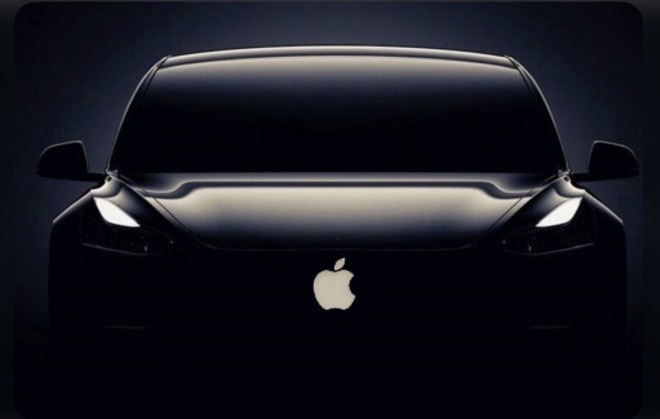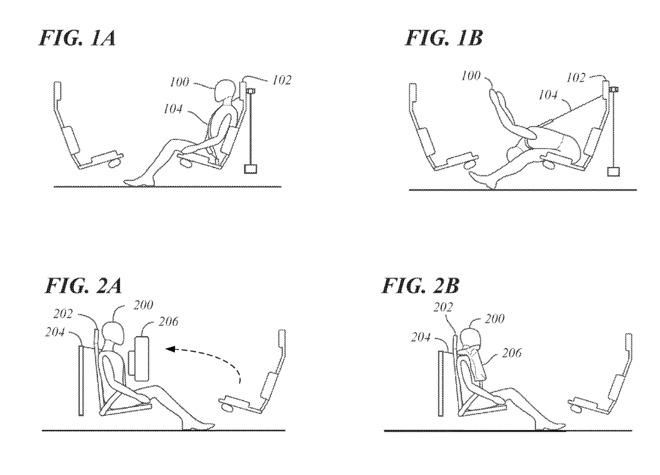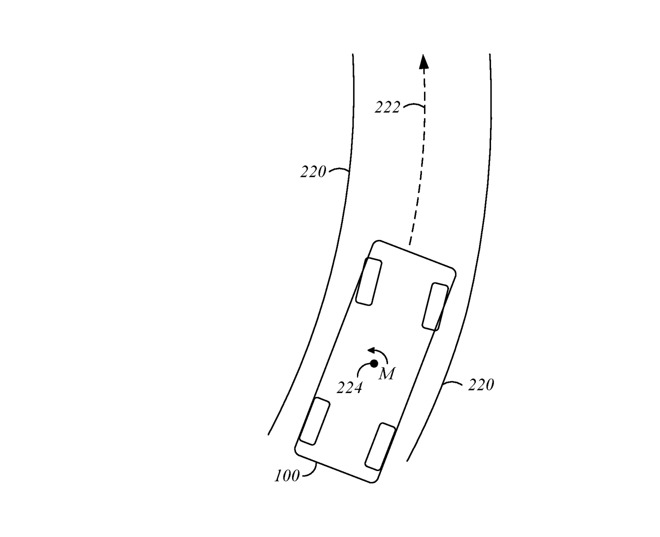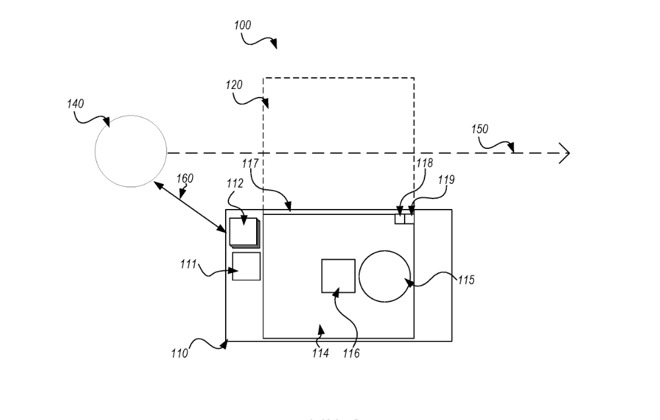Apple doubles down on self-driving safety research for 'Apple Car'
A series of newly-granted patents show that Apple aims to make extensive and automatic safety features a key focus of the design of the forthcoming "Apple Car."

Credit: AppleInsider
Cars are dangerous machines and there will be deaths when the rumored "Apple Car" gets into accidents. A whole series of new patents granted to Apple, though, suggest that the company is working hard to prevent any possible preventable accident.
That includes whether or not the "Apple Car" is driving itself, or you are. But the first of four newly granted patents does focus on cars that solely function as self-driving.
"Airbag-based occupant safety system," details what happens when your seat is not facing the dashboard, or steering wheel, where airbags are usually housed. Backing up this idea that Apple is truly sweating the details, this is actually the second patent granted for an airbag solution.
Both patents are chiefly credited to the same people, too. So Apple is refining and iterating designs in order to increase safety.
"In non-traditional vehicle designs," says Apple, "for example, where rows of occupants face each other within the passenger compartment or where the vehicle is designed without roof rails, there are limited options for reaction surfaces and tethers."
"New approaches to airbag-based occupant safety systems are thus desired," it continues.
The refinements in this patent actually remove one point to do with moveable seats. It's also different from the previous patent in how it proposes inflatable restraints, or airbags, can be deployed "from opposing interior surfaces of a passenger compartment."

Detail from the patent showing a range of possible airbag deployments
Previously, the team examined such airbag-like restraints coming from "lap portions of a tensioned restraint." There's no reason to assume the new patent supersedes or replaces the previous one, however.
It's more a sign that Apple is figuring out airbag deployment based on different internal designs for the "Apple Car." Part of these possible designs includes configurations where the user always drives, or can take over from the self-driving controls.
"Upon determining that the vehicle has lost stability, the electronic stability control system can apply braking at the road wheels individually and/or request propulsion torque to regain stability," says Apple in "Integrated chassis control."
"For example, braking may be applied to the outer front wheel to counter oversteer or braking may be applied to the inner rear wheel to counter understeer," continues the patent. "By minimizing the disparity between the desired chassis yaw rate and the measured chassis yaw rate, the electronic stability control system allows the vehicle to retain some degree of controllability."
This does require the "Apple Car" to recognize an unintentional loss of stability, and this patent is primarily concerned with how it determines that.
"The electronic stability control system may determine that the vehicle has lost stability based on a deviation of the vehicle's actual measured states from desired states such as deviation of an actual yaw rate of the vehicle from a desired yaw rate," says Apple.

Detail from the patent showing the car detecting unstable, unintended movement
"The desired states may be estimated based on driver inputs that imply an intended course for the vehicle, such as steering inputs," continues the patent.
Specifically, "Dynamic element protection," details situations where the "Apple Car" might choose to lock the doors rather than have a driver step out into a hazardous environment.
"Elements in an environment can include dynamic elements that can change location within an environment, including vehicles, humans, animal life, etc," says this patent.
"In some cases, dynamic elements can pose a hazard to a vehicle, including occupants of the vehicle," it continues. "For example, a dynamic element can collide with an occupied vehicle. In another example, a dynamic element can pose a hazard to individuals entering and exiting a vehicle interior."
Really, though, this is less about sensors thinking you'll slip on ice outside your car door. It's more an extension of familiar car systems that include proximity detectors.
Those typically sound an alert if you're about to reverse just a bit too far and hit a car behind you. In Apple's case, the proximity sensors also calculate the "sweep volume" of the car doors.

When an object will pass close enough to be hit by the car door, "Apple Car" may block or lock that door to protect passengers
Knowing how wide the door could swing open, the car can calculate when something outside is "moving along a trajectory that intersects at least a portion of the sweep volume of the door."
It needn't keep sensing the outside environment, however, because "Apple Car" may also be sensing the interior. That means that, "based on determination of the proximity of the occupant to the latch device of the door," the Car could "selectively restrict the door from moving".
So it might not lock the door, it might block it from fully opening instead. Rather like the overhead proximity sensor on a Tesla Model Y where the rear hatch will automatically stop before it can hit a carpark ceiling.
Just blocking the door's sweep, though, could also be dangerous if you're hurrying to get out. So alternatively, this system could "provide a warning prompt to the occupant of the vehicle."
Now granted to Apple, this patent could mean that the car windscreen would show a heads-up display that alerts the driver to situations that are not yet clear. For instance, it could show that there will be a marked bend in the road coming up.
This patent proposes mixing, effectively, Apple Maps data, with what the car is currently sensing outside. It also concentrates on describing ways where the effectiveness of sensors can be reduced, meaning a greater need for other sources of data.
Each of these four newly-granted patents details a different part of the "Apple Car" system, but of course each will work alongside the other. So the augmented reality display might show the proximity warnings, for instance.
In each case, the patents are intentionally as broad-ranging as possible. But they all describe specific features of the car -- and are concerned overall with the safety of the driver and passengers.

Credit: AppleInsider
Cars are dangerous machines and there will be deaths when the rumored "Apple Car" gets into accidents. A whole series of new patents granted to Apple, though, suggest that the company is working hard to prevent any possible preventable accident.
That includes whether or not the "Apple Car" is driving itself, or you are. But the first of four newly granted patents does focus on cars that solely function as self-driving.
"Airbag-based occupant safety system," details what happens when your seat is not facing the dashboard, or steering wheel, where airbags are usually housed. Backing up this idea that Apple is truly sweating the details, this is actually the second patent granted for an airbag solution.
Both patents are chiefly credited to the same people, too. So Apple is refining and iterating designs in order to increase safety.
"In non-traditional vehicle designs," says Apple, "for example, where rows of occupants face each other within the passenger compartment or where the vehicle is designed without roof rails, there are limited options for reaction surfaces and tethers."
"New approaches to airbag-based occupant safety systems are thus desired," it continues.
The refinements in this patent actually remove one point to do with moveable seats. It's also different from the previous patent in how it proposes inflatable restraints, or airbags, can be deployed "from opposing interior surfaces of a passenger compartment."

Detail from the patent showing a range of possible airbag deployments
Previously, the team examined such airbag-like restraints coming from "lap portions of a tensioned restraint." There's no reason to assume the new patent supersedes or replaces the previous one, however.
It's more a sign that Apple is figuring out airbag deployment based on different internal designs for the "Apple Car." Part of these possible designs includes configurations where the user always drives, or can take over from the self-driving controls.
Loss of control
Regardless of who is driving, there are going to be situations where the car goes out of control or, as Apple describes it, suffers a "loss of directional stability." Whether that's through driver error or road conditions, another Apple patent proposes that the car itself should be able to intervene."Upon determining that the vehicle has lost stability, the electronic stability control system can apply braking at the road wheels individually and/or request propulsion torque to regain stability," says Apple in "Integrated chassis control."
"For example, braking may be applied to the outer front wheel to counter oversteer or braking may be applied to the inner rear wheel to counter understeer," continues the patent. "By minimizing the disparity between the desired chassis yaw rate and the measured chassis yaw rate, the electronic stability control system allows the vehicle to retain some degree of controllability."
This does require the "Apple Car" to recognize an unintentional loss of stability, and this patent is primarily concerned with how it determines that.
"The electronic stability control system may determine that the vehicle has lost stability based on a deviation of the vehicle's actual measured states from desired states such as deviation of an actual yaw rate of the vehicle from a desired yaw rate," says Apple.

Detail from the patent showing the car detecting unstable, unintended movement
"The desired states may be estimated based on driver inputs that imply an intended course for the vehicle, such as steering inputs," continues the patent.
Mitigating other dangers
These patents for the airbags and restoring directional control, are obviously chiefly intended for when the car is moving. A third newly-granted Apple patent concentrates on that plus when the car is stopped.Specifically, "Dynamic element protection," details situations where the "Apple Car" might choose to lock the doors rather than have a driver step out into a hazardous environment.
"Elements in an environment can include dynamic elements that can change location within an environment, including vehicles, humans, animal life, etc," says this patent.
"In some cases, dynamic elements can pose a hazard to a vehicle, including occupants of the vehicle," it continues. "For example, a dynamic element can collide with an occupied vehicle. In another example, a dynamic element can pose a hazard to individuals entering and exiting a vehicle interior."
Really, though, this is less about sensors thinking you'll slip on ice outside your car door. It's more an extension of familiar car systems that include proximity detectors.
Those typically sound an alert if you're about to reverse just a bit too far and hit a car behind you. In Apple's case, the proximity sensors also calculate the "sweep volume" of the car doors.

When an object will pass close enough to be hit by the car door, "Apple Car" may block or lock that door to protect passengers
Knowing how wide the door could swing open, the car can calculate when something outside is "moving along a trajectory that intersects at least a portion of the sweep volume of the door."
It needn't keep sensing the outside environment, however, because "Apple Car" may also be sensing the interior. That means that, "based on determination of the proximity of the occupant to the latch device of the door," the Car could "selectively restrict the door from moving".
So it might not lock the door, it might block it from fully opening instead. Rather like the overhead proximity sensor on a Tesla Model Y where the rear hatch will automatically stop before it can hit a carpark ceiling.
Just blocking the door's sweep, though, could also be dangerous if you're hurrying to get out. So alternatively, this system could "provide a warning prompt to the occupant of the vehicle."
Displaying the outside environment
The last of four newly-revealed patents regarding "Apple Car" safety does mean the vehicle constantly sensing the exterior environment. As described when it was a patent application, "Augmented reality display," describes how "Apple Car" could use Apple AR to show a driver important information.Now granted to Apple, this patent could mean that the car windscreen would show a heads-up display that alerts the driver to situations that are not yet clear. For instance, it could show that there will be a marked bend in the road coming up.
This patent proposes mixing, effectively, Apple Maps data, with what the car is currently sensing outside. It also concentrates on describing ways where the effectiveness of sensors can be reduced, meaning a greater need for other sources of data.
Each of these four newly-granted patents details a different part of the "Apple Car" system, but of course each will work alongside the other. So the augmented reality display might show the proximity warnings, for instance.
In each case, the patents are intentionally as broad-ranging as possible. But they all describe specific features of the car -- and are concerned overall with the safety of the driver and passengers.

Comments
https://www.caranddriver.com/features/a34741342/crash-vs-accident/